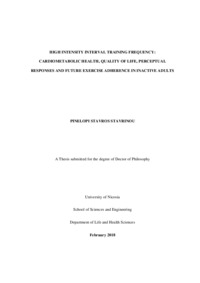- Stavrinou, Pinelopi
- School of Sciences and Engineering
- Department of Life and Health Sciences
- February 2018
- English
- 162 pages
- Hadjicharalambous, Marios
- Ηigh intensity training | Frequency | Health | Perceptual responses
- Health -- Training
- Original: Unic - Rules: RDA
-
-
Physical inactivity is a critical public health concern and lack of time is reported as the main barrier for not engaging in regular physical activity. High intensity interval training (HIIT) is considered as an effective and time efficient training mode. However, whether HIIT with a reduced frequency is an efficient physical activity strategy is less clear. Furthermore, there is the need of a comprehensive study that would evaluate not only the physiological adaptations to HIIT but also the psychological factors and moreover to determine the utility of HIIT as an exercise strategy for promoting future physical activity participation. Therefore, the aim of this thesis was to investigate and compare the efficacy of HIIT with low and moderate training frequency (2 and 3 times per week) on physiological and metabolic variables, on perceptual and quality of life responses and to examine whether this intervention could influence future exercise participation in healthy inactive adults . Thirty five healthy inactive adults (age: 31.7±2.6 yrs, VO2peak: 32.7±7.4 ml·kg-1·min-1) were randomly assigned to a control and two training groups, which performed 10 x 60 s cycling at ~83% of peak power, two (HIIT-2) or three times per week (HIIT-3) for 8 weeks. Prior and after the HIIT intervention, cardiorespiratory fitness, body composition, biochemical variables and quality of life were evaluated. Furthermore, following the HIIT intervention, exercise enjoyment and the intention to implement ΗΙΙΤ in the future were evaluated. Eight weeks after cessation of the training stimulus, follow-up evaluations of quality of life and physical activity were performed. The results demonstrated that following 8 weeks of HIIT 2 or 3 times per week, similar improvements were found in both training groups in peak oxygen uptake, insulin concentration during a 2-hour oral glucose tolerance test, waist circumference, thigh lean cross sectional area and physical health component of quality of life. However, a decrease in total body fat, trunk fat, total and low-density lipoprotein cholesterol and an enhancement of mental health component and total score of quality of life were observed only after HIIT-3. Regarding perceptual responses both training groups displayed manageable ratings of perceived exertion, enjoyment and intentions to implement HIIT in the future. During the follow up period, vigorous and total physical activity as well as total score of quality of life was increased in both training groups compared to baseline. The change in total score of quality of life between baseline and follow up was correlated with the corresponding change in vigorous physical activity.
In conclusion, the current results suggest that 8 weeks of low frequency HIIT (2 times/week) is effective in promoting particular cardiometabolic health indices, quality of life and positive perceptual responses in inactive adults. However, a higher HIIT frequency (3 times/week) is required for body fat reduction, blood lipid profile and on mental well-being. Moreover HIIT, regardless of training frequency, appears to influence future exercise participation.
-


